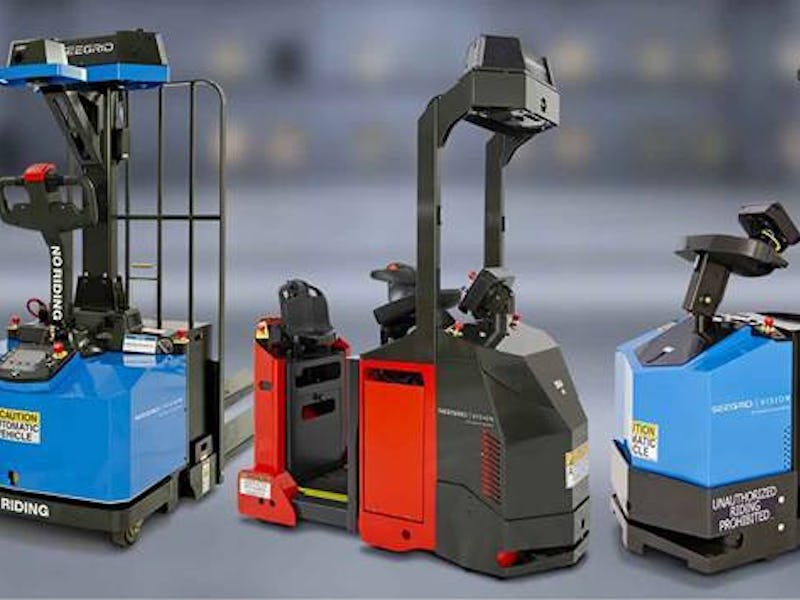What the Rise of Autonomous Forklifts Can Teach Us About Accepting Self-Driving Cars
Just look to the factories.

The technology to make fully autonomous vehicles has surpassed the public’s autonomous vehicle acceptance threshold. In a AAA study released in March, 75 percent of drivers in the United States said they would be afraid to ride in a self-driving car, and only 20 percent of drivers said they would trust a vehicle to drive itself.
There are several ways auto manufacturers are handling this. There’s the GM and Lyft method that will debut in 2017, which will treat ride-sharing like a free Costco sample by giving people a taste of autonomy before they buy into it for themselves. And then there’s “hybrid adoption” — like what Tesla is doing with Autopilot. Elon Musk says that Tesla will always offer people a choice between manual and autonomous, but in theory, slightly increasing the level of autonomy with each Autopilot upgrade could Inception people into acceptance.
The main difference between the two: Hybrid adoption has already proven itself as a viable solution. The evidence can be found in the forklift industry.
Forklifts that indicate the future.
What autonomous forklifts can teach the consumer car industry
A company called Seegrid has been selling autonomous, vision-guided forklifts to factories since 2003. Jaguar, Walgreens, and the United States Postal Service are just a few of the places taking advantage of Seegrid’s self-driving machines. Getting to that level of acceptance, however, didn’t happen overnight.
“I think there’s a sort of transition that our products often use,” Jeff Christensen, Seegrid’s vice president of products and services, tells Inverse. “And since we’re using a regular, manually driven truck and then adding things on top of it, you can still manually drive it.”
In other words, factory workers are on the same page as the autonomous forklifts. The hybrid adoption has proven that it can lead to wide-scale acceptance. It also helps autonomous development, since data can be gathered in real-world situations while the technology is being worked on.
“If you can do autonomy for 90 or 95 percent of the things the vehicle needs to do,” Christensen says, “that last 5 percent might be very, very difficult to automate. So by making it a hybrid, you can cover 100 percent of the use cases much more effectively.”
Off and away.
What the people want
The AAA survey found that 60 percent of drivers want semi-autonomous technology in their next vehicle. It’s a good first step to wider acceptance of an inevitable outcome, but that still leaves 40 percent of people who won’t experience the same transitory technological steps.
Autonomy won’t be for everyone, at least not in the short term. But, red-dirt backroads aren’t the type of environment car manufacturers are focusing their autonomous development on. So, for the majority of people, self-driving cars mean safer trips, less traffic, and more free time during the daily commute.
“The person driving something on a giant loop and doing the same thing every day,” Christensen says, can do something that is much higher value if they move off of that.”
In a factory, that means moving to a more complex job. In the consumer market, that means things like answering emails or bonding with your partner.
Insisting on cars without autonomous features is like insisting on using a typewriter because computers can crash and delete the novel you have been working on at Starbucks all year.
Look to a factory for a vision of the future
The loud sirens, flashing lights, and frenetic pace of a modern factory isnt the first place someone would look for the future of consumer automation. Yet it’s the very place where the future of cars can be seen.
Consumer vehicles will require a lot more sophisticated technology to enter the market. Factory vehicles never encounter sleet and snow, and will never travel at high speeds. But factory workers did have to learn to accept and work with the very vehicles that were taking their jobs, and one of the main things keeping the autonomous industry from rapidly evolving in the consumer market is lagging legislative acceptance and underdeveloped understanding of the safety and benefits.
Seegrid has shown that hybrid adoption can speed up acceptance and, as Christensen says, “it’s part of that transition into automation, we can do this incrementally.”
If the consumer market wants to improve the way people view their autonomous vehicles, they just have to look to factories and hybrid adoptability.